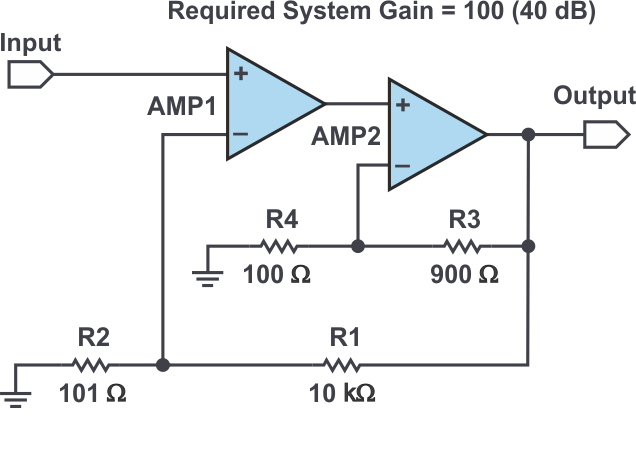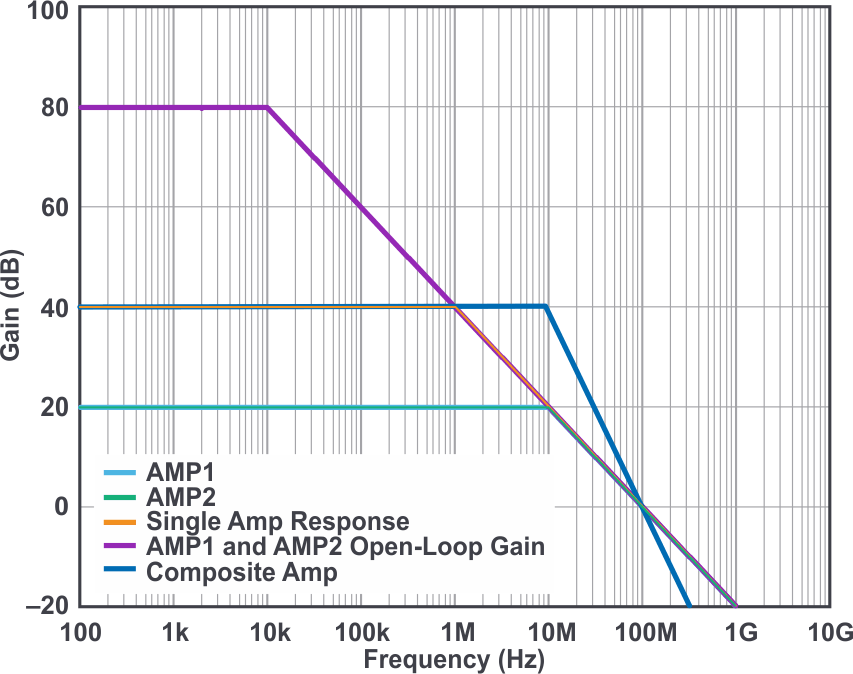by Jino Loquinario, Analog Devices
Analog Dialogue
Introduction
It is normal, and almost expected, to be faced with applications for which a solution does not appear to exist. To meet their requirements would require us to think of a solution that is beyond the performance of current products that the market offers. For example, an application may require an amplifier that is high speed and high voltage with high output drive capability, but may also demand excellent dc precision, low noise, low distortion, etc.
Amplifiers that meet the speed and output voltage/current requirements and amplifiers with outstanding dc precision are readily available in the market – many of them, in fact. However, all the requirements may not exist in a single amplifier. When faced with this problem, some would think it is impossible for us to meet the demands of such applications, and that we must settle for a mediocre solution and go with either a precision amplifier or a high speed amplifier, perhaps sacrificing some of the requirements. Fortunately, this is not entirely true. There is a solution for this in the form of a composite amplifier, and this article will show how it is possible.
The Composite Amplifier
A composite amplifier is an arrangement of two individual amplifiers configured in such a way as to realize the benefits of each individual amplifier while diminishing the drawbacks of each amplifier.
 |
||
| Figure 1. | Simple composite amplifier configuration. | |
Referring to Figure 1, AMP1 should have excellent dc precision as well as the noise and distortion performance required by the application. AMP2 should provide the output drive requirements. In this arrangement, the amplifier (AMP2) with required output specifications is placed inside the feedback loop of an amplifier (AMP1) with the required input specifications. Some of the techniques and benefits of this arrangement will be discussed.
Setting the Gain
When initially encountering a composite amplifier, the first question that may arise is how to set the gain. To address this, it is helpful to view the composite amplifier as a single noninverting op amp contained within the large triangle, as in Figure 2. If we imagine the triangle is blacked out so that we couldn’t see what’s inside, then the gain of the noninverting op amp is 1 + R1/R2. Revealing the composite configuration inside the triangle doesn’t change anything – the gain of the whole thing is still controlled by the ratio of R1 and R2.
 |
||
| Figure 2. | Composite amplifier seen as a single amplifier. | |
In this configuration it is tempting to think that changing the gain of AMP2 by means of R3 and R4 will affect the output level of AMP2, indicating a change in composite gain, but this is not the case. Increasing the gain around AMP2 via R3 and R4 will simply decrease the effective gain, and output level, of AMP1 such that the output of the composite (AMP2 output) remains unchanged. Alternatively, decreasing the gain around AMP2 will serve to increase the effective gain of AMP1. So, in general, the gain of the composite amplifier is only dependent on R1 and R2.
This article will discuss the major benefits and design considerations when implementing a composite amplifier configuration. The effects on bandwidth, dc precision, noise, and distortion will be highlighted.
Bandwidth Extension
One of the major benefits of implementing a composite amplifier is the extended bandwidth as compared to a single amplifier configured with the same gain.
 |
||
| Figure 3. | Composite amplifier at unity gain. | |
Referring to Figure 3 and Figure 4, let’s say we have two separate amplifiers each having a gain-bandwidth product (GBWP) of 100 MHz. Putting them together in a composite configuration will increase the effective GBWP of the combination. At unity gain, the composite amplifier offers a ~27% higher –3 dB bandwidth, albeit with a small amount of peaking. However, at higher gains this benefit becomes much more noticeable.
 |
||
| Figure 4. | –3 dB BW improvement at unity gain. | |
Figure 5 shows the composite amplifier in a gain of 10. Note the composite gain is set to 10 via R1 and R2. The gain around AMP2 is set to approximately 3.16, forcing the effective gain of AMP1 to be the same. Splitting the gain equally between the two amplifiers yields the greatest possible bandwidth.
 |
||
| Figure 5. | Composite amplifier configured for gain = 10. | |
Figure 6 shows the frequency response for a single amplifier at a gain of 10 compared to a composite amplifier configured with the same gain. In this case, the composite offers a ~300% increase in –3 dB bandwidth. How is this possible?
 |
||
| Figure 6. | –3 dB BW improvement for gain = 10. | |
For a specific example, refer to Figure 7 and Figure 8. We require a system gain of 40 dB and will use two identical amplifiers, each with an open-loop gain of 80 dB and a GBWP of 100 MHz.
 |
||
| Figure 7. | Gain splitting for maximum bandwidth. | |
To realize the highest possible bandwidth for the combination, we will split the required system gain equally between the two amplifiers, giving each of them a gain of 20 dB. So, setting the closed-loop gain of AMP2 to 20 dB forces the effective closed-loop gain of AMP1 to 20 dB as well. With this gain configuration, both amplifiers operate lower on the open-loop curve than either of them would at a gain of 40 dB. As a result, the composite will have higher bandwidth at the gain of 40 dB as compared to the single amplifier solution of the same gain.
 |
||
| Figure 8. | Expected response of a single amplifier. | |
Although this may sound relatively simple and easy to implement, proper care should be taken in designing the composite amplifier to have the highest possible bandwidth without sacrificing the stability of the combination. In real-world applications where amplifiers are nonideal, and probably nonidentical, a proper gain arrangement must be ensured to maintain stability. Also, note that the composite gain will roll off at –40 dB/decade, so one must be careful when distributing the gain between the two stages.
In some cases, splitting the gain equally may not be possible. To that point, equal distribution of the gain between the two amplifiers requires that the GBWP of AMP2 must always be greater than or equal to GBWP of AMP1, otherwise peaking – and possibly instability – will result. In a case where AMP1 GBWP must be greater than AMP2 GBWP, the instability can typically be corrected by redistribution of the gain between the two amplifiers. In this case, reducing the gain of AMP2 causes an increase in the effective gain of AMP1. The result is that AMP1 closed-loop BW is decreased as it operates higher on the open-loop curve and AMP2 closed-loop bandwidth is increased as it operates lower on the open-loop curve. If this slowing down of AMP1 and speeding up of AMP2 is adequately applied, the stability of the composite combination is restored.
For this article, the AD8397 was picked as the output stage (AMP2), interfaced with various precision amplifiers for AMP1 to demonstrate the benefits of a composite amplifier (Table 1). The AD8397 is a high output current amplifier capable of delivering 310 mA.
| Table 1. | Bandwidth Extension on Different Amplifier Combinations for Gain of 10 and VOUT = 10 V p-p |
||||||||||||||||
|
|||||||||||||||||
